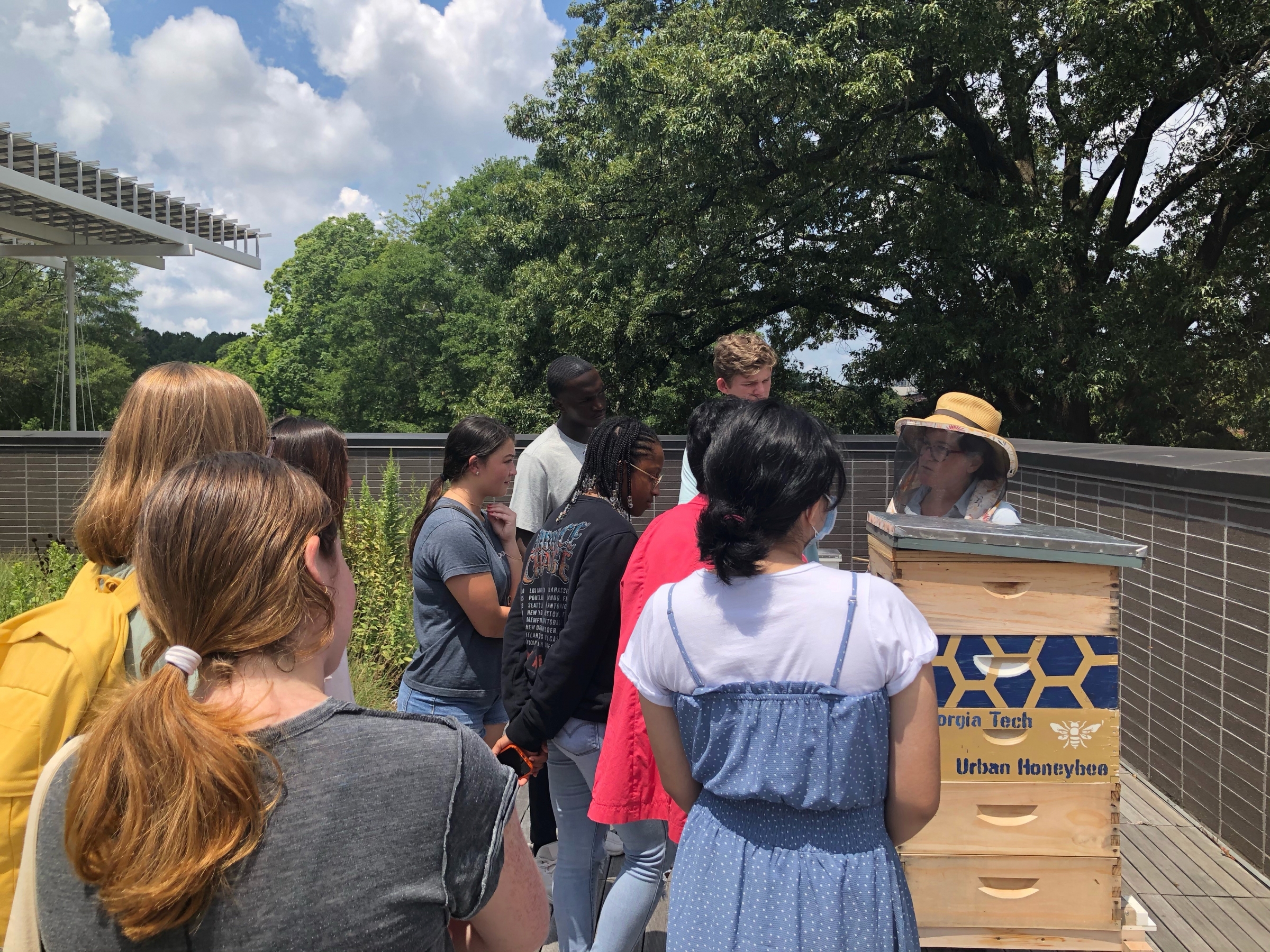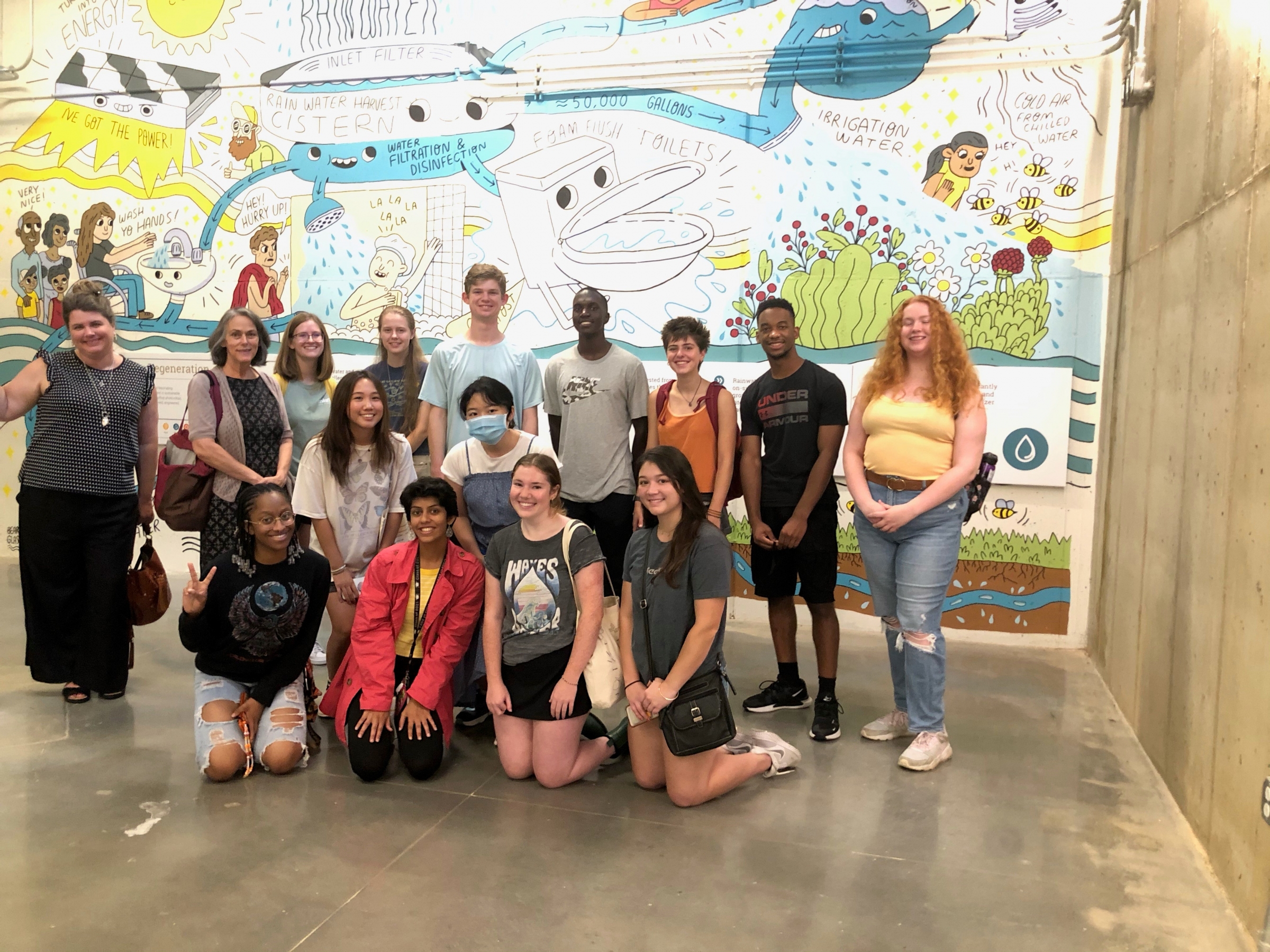SLS partnered last month with Summer and Special Sessions Initiatives to offer iGniTe students an in-person tour of the Kendeda Building. Summer and Special Sessions intern, Lily Arnold, wrote about her experience on the tour:
 Recently I had the opportunity to take an official tour of the Kendeda Building here on campus. Before going on this tour, the only thing I knew about the building was the foamy toilets. I didn’t know how they worked or anything like that, just that they foamed up over your deposit and whisk it away unlike a traditional toilet and what I refer to as its WOOSH. Once before the tour I took a solo visit to Kendeda & ended up texting some of my friends in panic asking if they knew how this toilet worked. I ended up fine as the foam dispenses automatically once the sensor detects someone in the stall, but I had no idea at the time that’s how they worked and worried that I just left waste for someone else to find. In this tour I learned much more about the toilet system & other parts of the building that helped Kendeda achieve the Living Building Certification from tour guide leader & building director Shan Arora.
Recently I had the opportunity to take an official tour of the Kendeda Building here on campus. Before going on this tour, the only thing I knew about the building was the foamy toilets. I didn’t know how they worked or anything like that, just that they foamed up over your deposit and whisk it away unlike a traditional toilet and what I refer to as its WOOSH. Once before the tour I took a solo visit to Kendeda & ended up texting some of my friends in panic asking if they knew how this toilet worked. I ended up fine as the foam dispenses automatically once the sensor detects someone in the stall, but I had no idea at the time that’s how they worked and worried that I just left waste for someone else to find. In this tour I learned much more about the toilet system & other parts of the building that helped Kendeda achieve the Living Building Certification from tour guide leader & building director Shan Arora.
Arora talked to us about how a building becomes a certified Living Building per the International Living Future Institute. A building must meet goals within seven different petals: Place, Water, Energy, Health & Happiness, Materials, Equity, and Beauty. Each petal contains set goals for its particular category & the building must satisfy these goals in all 7 petals for certification. A big part of several of the petals is being “net-positive,” which means that instead of having a negative impact on our environment, the building is to have a positive one. Other petals focus on the building’s use, such as the Equity petal focusing on how the building gives equal access to all & encourages socialization. Throughout the tour, Arora would always bring his explanations back to one of these 7 petals.
Turning back to the infamous foamy toilets, these toilets save and compost the waste deposited while using zero water, compared to regular toilets that typically account for 70-80% of water usage in a building. These toilets help Kendeda satisfy requirements for the water petal by ensuring no blackwater is produced, which is net-negative rather than net-positive. For the sinks in the bathrooms & the water fountains, the building is designed to collect & store rainwater for use as the sole water source for the building. Any water collected within Kendeda is cycled into a graywater treatment system held in-house that filters the water for use, also helping in the satisfaction of the water petal.
 My biggest takeaway from this tour is how anything within Kendeda has some sort of story of how and why it ended up there and to me, it’s these stories that make the building alive. I don’t think any other campus building is as unique as Kendeda and is an absolute "must visit" while at Georgia Tech. If you’d like to learn more details about the building, visit the links below or stop by during your next walk down Ferst Drive.
My biggest takeaway from this tour is how anything within Kendeda has some sort of story of how and why it ended up there and to me, it’s these stories that make the building alive. I don’t think any other campus building is as unique as Kendeda and is an absolute "must visit" while at Georgia Tech. If you’d like to learn more details about the building, visit the links below or stop by during your next walk down Ferst Drive.
https://living-future.org/lbc/case-studies/the-kendeda-building-for-innovative-sustainable-design
https://livingbuilding.gatech.edu/kendeda-building-innovative-sustainable-design

Interested in teaching a class in the Kendeda Building?
SLS oversees scheduling for two Kendeda classrooms: Room 110 Design Studio (24 seats) and Room 118 Seminar Rood (16 seats). Read more about these classrooms and how to request them HERE. Please note that as a general rule, classes taught in these rooms are expected to affiliate with SLS. If you are not familiar with SLS affiliation, you can read about it HERE.
Interested in studying more about the Kendeda Building?
There are several Vertically Integrated Projects (VIPs) associated with the Kendeda Building. These include:
Building for Equity and Sustainability
To learn more about VIPs, course requirements and credits, and how to apply, visit their website HERE.